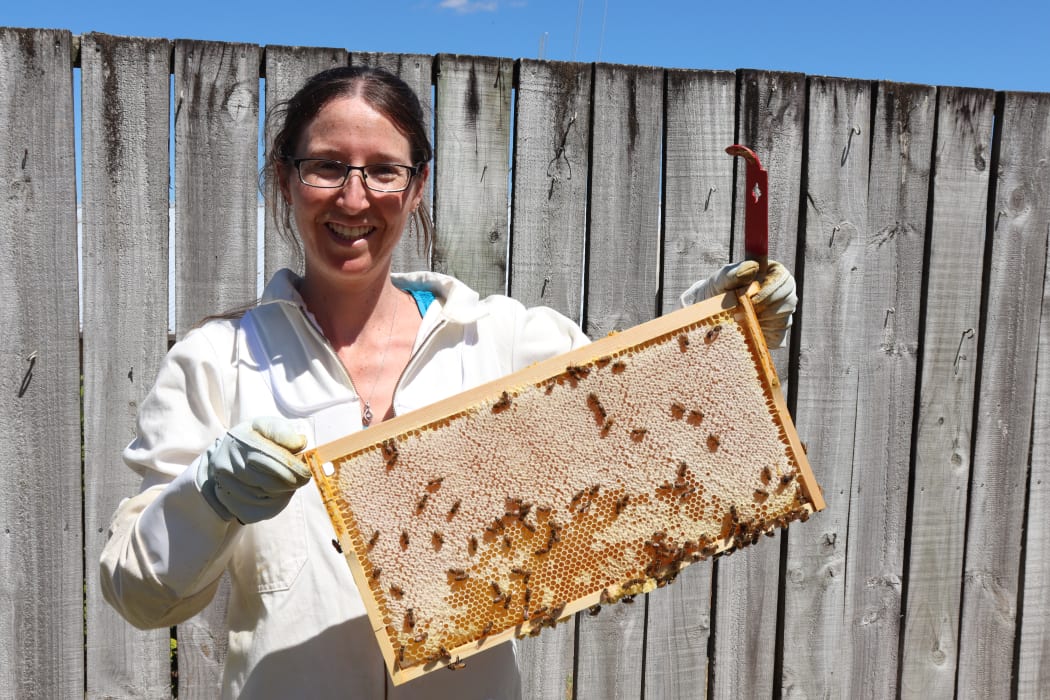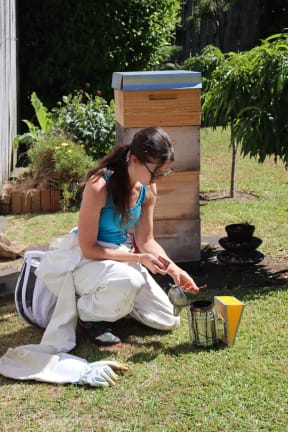Honey is big business in Aotearoa. An estimated 27,000 tonnes of honey was produced in the 2019/20 season, with the value of honey exports for that time at $425 million. So New Zealand honey is in global demand, but how can you be sure that honey labelled as New Zealand origin was really made here?

Dr. Megan Grainger tends her bees at home. Photo: Supplied
Follow Our Changing World on Apple Podcasts, Spotify, Stitcher, iHeartRADIO, Google Podcasts, RadioPublic or wherever you listen to your podcasts.
The fingerprint of honey

Dr. Megan Grainger with her hive Photo: Supplied
This is what Dr. Megan Grainger hopes to help address with her latest research. Megan has been investigating the elemental fingerprint of different New Zealand honeys and comparing them across regions and with honey from overseas.
The elemental composition of rocks and soils in different locations is taken up by the plants, represented in the nectar, and subsequently in the honey made from that nectar. By using analytical chemistry techniques and equipment, Megan can profile what elements are in the honey and what concentrations they are found in. By analysing over 200 different samples of honey she has been able to build up a picture of what the elemental fingerprint of honey from different regions in the North Island looks like.
Megan has also identified tiny amounts of so-called 'heavy metal' elements in the honey, things like lead, mercury and cadmium, which are linked to human activity. This has sparked her next avenue of research - figuring out if and how these impact the bee's activities and if they could play a role in declining bee populations and colony health.
Plant powers
When microorganisms get in to the soil from manure spreading or livestock excrement, it can lead to further issues downstream when they get into our water ways and impact water quality.
To figure out how to combat this a team at the Bioprotection Aotearoa research centre have turned to native plants.
After testing 12 native plant species for antimicrobial properties, the team have shown that extracts of some of the species are effective at reducing e.coli contamination in soil in a greenhouse experiment. Extracts from northern rātā and swamp mānuka could reduce e.coli by 90% after 14 days, compared with the 45 days it took to see this level of reduction with a control plant extract.
Katy Gosset finds out more at the Bioprotection Aotearoa Research Centre.

Hossein Alizadeh with a swamp manuka sample grown in the lab Photo: Katy Gosset/RNZ
Learn more
- Read the Marsden Fund Fast-Start grant summary into Megan's upcoming research.
- Megan has her own website where she talks about her research.
- Bioprotection have written a blog about the research work into the antibacterial abilities of native plants and the published paper on the work done by Hossein and others is available here.


